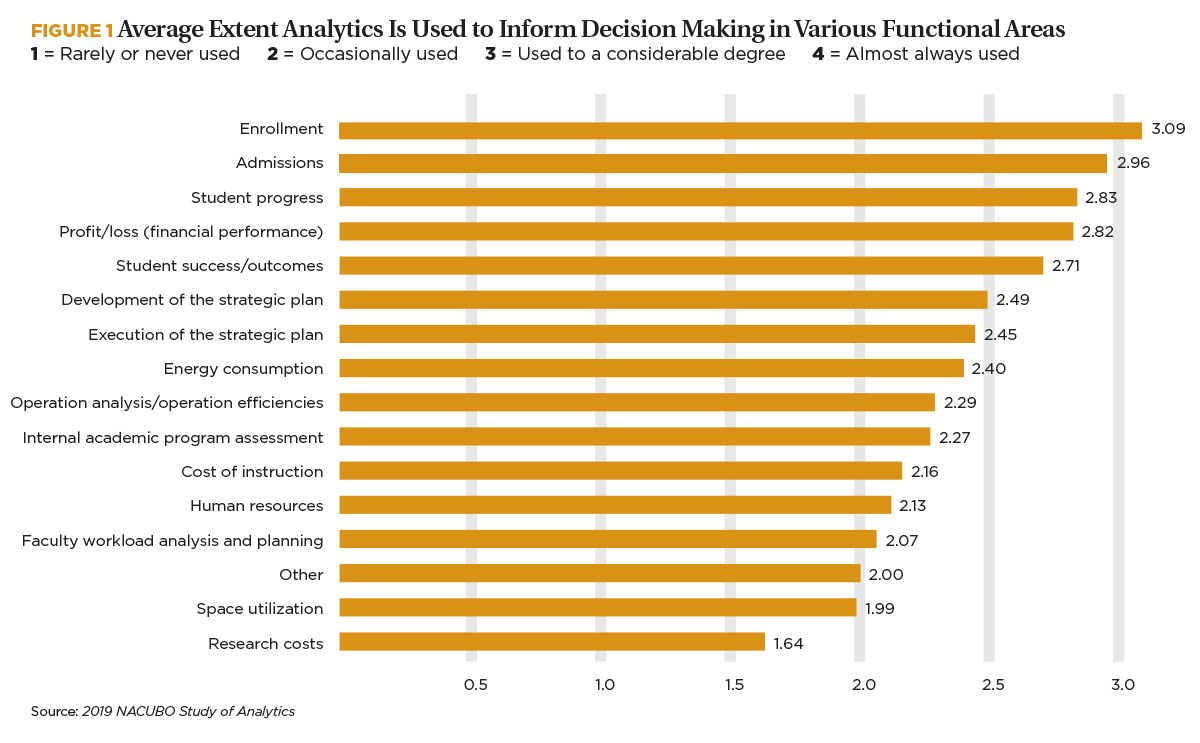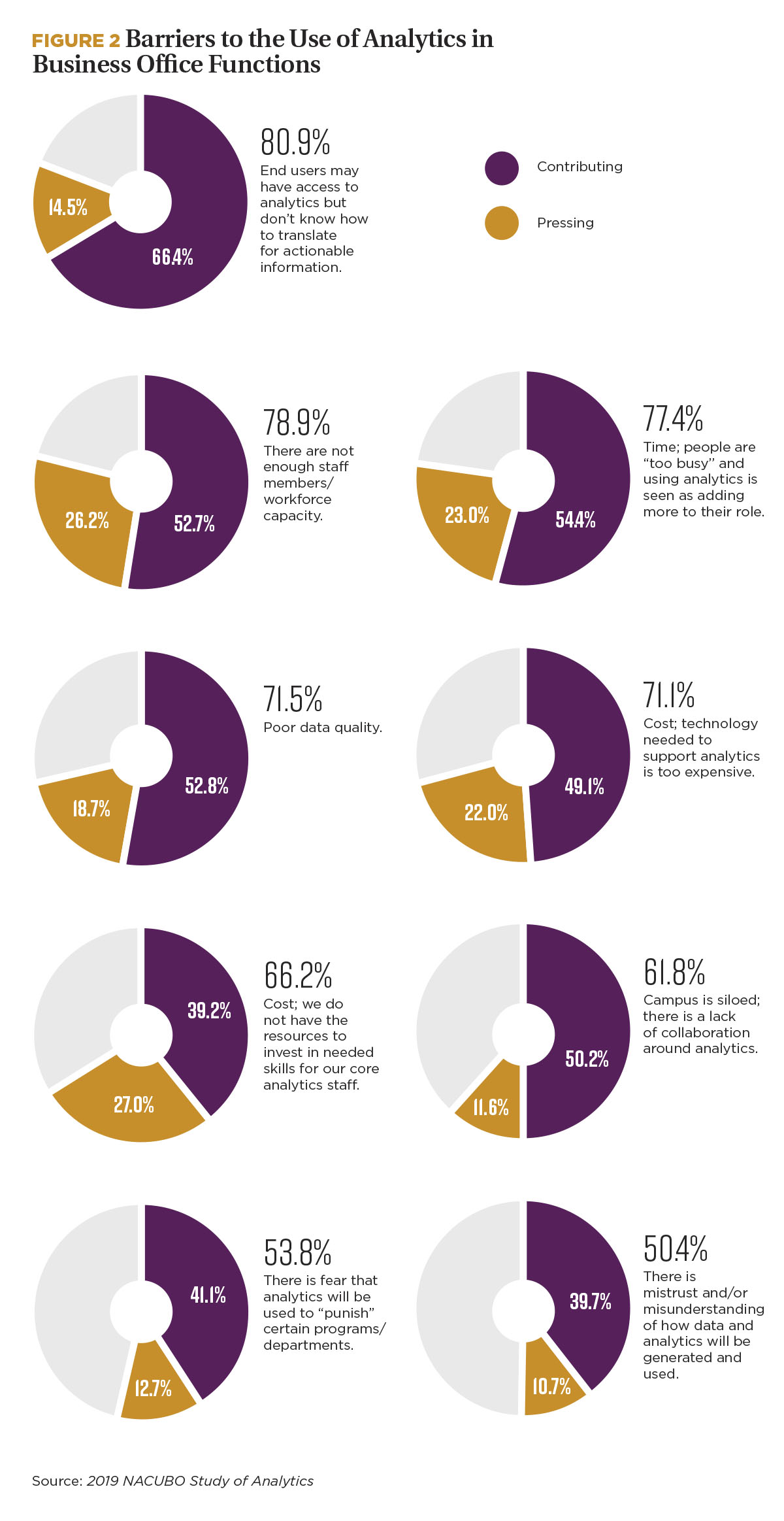Many aspects of the higher education landscape are changing. National demographic shifts mean that both who attends colleges and how colleges compete for enrollments are changing. Expectations about higher education have also shifted, with more focus on the link between degrees and employment outcomes—as well as a public concern about whether higher education is delivering on this equation. In addition, the funding environment is becoming more complex, and public and private institutions alike are being challenged to find more efficient ways to allocate scarce resources. Colleges and universities can leverage data analytics to help them navigate these myriad challenges.
A Snapshot of Analytics on Campus
The responses of business officers from 334 institutions included in the 2019 NACUBO Study of Analytics reveal some of the ways institutions are using data and analytics as assets to support their decision making. For Sherri Newcomb, senior vice president and chief operating officer at the City University of New York’s Queensborough Community College, Bayside, accessing the power of data analytics to guide decision making has enabled her campus to design interventions for students at risk, improve class schedules to better enable student progress, and explore student performance in every course section longitudinally and at a granular level to identify actionable information. Newcomb says, “There are many other examples, but I am highlighting these because they reinforce a mantra of mine: By focusing on student success, you are able to better inform financial and strategic planning [as a CBO].”
According to the study, business officers indicated that the functional areas in which they used analytics most often, on average, were enrollment and admissions (see Figure 1). This finding certainly makes sense within the increasingly challenging higher education landscape of changing demographics and increased competitiveness for enrollments. To a slightly lesser extent, on average, study findings show that institutions are using analytics to support decisions related to student progress, financial performance, and student outcomes “to a considerable degree,” further supporting the idea that colleges and universities are using analytics. Business officers recognize that data analytics is a compelling resource in meeting the new demands of the complex world of higher education.

Visions of the Future
Study findings also reveal those functional areas where business officers thought their institutions should be placing more importance on using analytics to support decisions. More than 90 percent of business officers thought more importance should be placed on using analytics to support decisions in operational efficiencies (94.9 percent), cost of instruction (92.3 percent), internal academic program assessment (91.2 percent), and faculty workload planning (91 percent). Business officers indicated that currently their institutions were only “occasionally” using analytics to support decisions in each of these areas (see Figure 1).
One example of an institution already using analytics to support operational efficiencies is Indiana University. IU’s Academic Metrics 360 (AM360) project is a suite of online decision-support dashboards designed to provide campus leadership, deans, department chairs, and individual unit administrators with an opportunity to view the health of academic responsibility centers and the operating units within schools. AM360 integrates student, enrollment, classroom, personnel, and financial data sourced daily and directly from its enterprise systems. Chris Puckett, associate director of campus business analytics, explains that this resource supports the institution by “providing all decision makers with the ability to readily measure, compare, and analyze from new perspectives the interrelationships of historical and current operational trends across traditionally ‘siloed’ reporting functions to analyze the health of academic responsibility centers, positioning them to be more strategic in planning for future activities.”
AM360 is one of several charters included in IU’s Decision Support Initiative, which is co-sponsored by both the CFO and CIO and has additional base budget personnel resources allocated to the project by the provost and executive vice president of IU’s Bloomington campus. As Puckett explains, this backing is critical because it means the institution has “the enviable and significant benefit of strong executive support and dedicated incremental resources assigned to project development, somewhat eliminating the ‘capacity’ challenges many other institutions face.”
What’s Getting in the Way
And other institutions do face challenges to the integration and use of analytics. Findings from the 2019 NACUBO Study of Analytics demonstrate that campuses face both cultural and capacity-related barriers—several barriers were indicated as “contributing” or “pressing” by more than half of the survey respondents (see Figure 2).
Barriers related to staff skills are among the most noteworthy. For example, the two areas identified by the largest shares of business officers as “pressing” were the cost of investing in the skills of a core analytics staff (27 percent) and not having enough staff members (26.2 percent). In short, the study reveals a concern among business officers that many core analytics staff members (i.e., IT, IR, and institutional effectiveness staff members) do not have the technical skills to facilitate the use of analytics, and, even if some do, there simply are not enough of them to facilitate campuswide use of analytics.
In addition, a lack of analytics skills among staff members across campuses is also a barrier. Although only 14.5 percent of participants said that end users not knowing how to translate analytics into actionable information was a “pressing” barrier, 66.4 percent cited it as a “contributing” barrier. This means that nearly 81 percent of business officers see the lack of end users’ skills as a barrier to the use of analytics.
How to Move Forward
These barriers can seem overwhelming for some institutions, making it difficult to initiate an analytics program. As Newcomb says, “Analytics can be pushed to the back burner, plus it is hard to know where to start.” To overcome such obstacles and gain a foothold on the path to leveraging analytics, Newcomb stresses the importance of executive sponsorship and having leaders who invest in the time and resources for strategic initiatives and innovation.
The roles that leaders may play on campus vary. For example, Newcomb says, “If the president and other executive colleagues simply know they ‘want’ analytics but do not know what specific questions they would like to answer, or don’t know the stories they would like to be able to tell with data (the ‘useful purpose’), then your first job is to manage up and inspire them as to what is possible.”
However, Newcomb cautions, “You also have to be realistic—analytics involves technologies, obviously, but is not a technology project. You can’t go to a vendor and buy a product to get you there.”
Try This Now
So, how can business officers help their institutions begin the analytics journey? Although Newcomb says, “This is a tough question with no ‘right’ answer,” both Newcomb and Puckett suggest a few avenues that could serve as starting points of an institution’s analytics journey.
Learn the lay of the land. Newcomb advises business officers to learn about roles and policies that can encourage the use of analytics. She suggests that business officers should familiarize themselves with the role of the chief data officer—and adds that business officers may even be able to fill this role. Newcomb cites Ashok Srivastava, senior vice president and chief data officer of Intuit Inc., as describing the CDO as “a person who thinks about the end-to-end process of obtaining data, data governance, and transforming that data for a useful purpose.”
In addition to learning about the role of the CDO, Newcomb also suggests business officers “advance the idea of an institutional data governance policy, one that may start with the straightforward idea of data as an institutional asset.” This process, she explains, helps break down silos so data are seen as an asset for the institution—and are not “owned” by any one unit or individual.
Newcomb also advises, “I would read as much as possible, attend webinars (there are many excellent free webinars and white papers) and vendor demonstrations (to learn what is out there, not to buy), and learn as much as possible about what is being done with analytics at other institutions.”
Aim for institutional priorities. Another place to start is to think about ways that analytics can support strategic priorities and the institutional mission. Puckett suggests, “Select a few well-defined institutional priority goals and develop pertinent business questions of strategic importance to address those goals, having identified in advance where relevant and verifiable data is available to address solutions.
“Then,” Puckett continues, “develop thoughtful, user-friendly analyses to display historical, current, and, if possible, projected future trajectories to inform current and prospective strategic decision making. If one solid analysis proves advantageous for strategic planning, the potential for institutional ‘buy-in’ and future incremental resource allocations supporting expansion increase.”
Ask hard questions. “One place to start,” Newcomb says, “is to look at every institutional report that comes across your desk and ask how the information in that report or fact book informs decision making or inspires a specific call to action. You may find that most do not, but you can then begin to envision what would.”
This process of developing critical questions can allow you, and other leaders on your campus, to begin identifying the things you would like to know in order to make decisions that better support students and your institution. This type of critical inquiry can help you think about ways to use analytics to learn about “the things you have to go deep for,” Newcomb says. She adds, “The character Sherlock Holmes said, ‘There is nothing more deceptive than an obvious fact.’ Analytics can uncover the full story and enable conversations to take place that would not otherwise be possible. I believe all higher education leaders have an obligation to place student success at the heart of everything we do, and that obligation includes using our vast stores of data to the very best of our ability to improve our ability to serve.”
LINDSAY WAYT is director, analytics, NACUBO.




